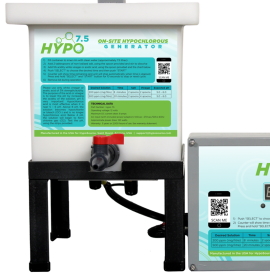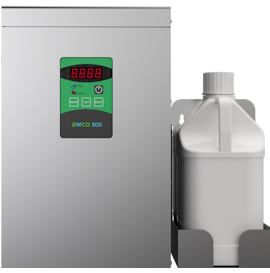Investigación > Industria > Livestock > Aplicación: All
Nombres Comunes para las Soluciones de Ácido Hipocloroso
- Electrolytically Generated Hypochlorous Acid
- Neutral Electrolyzed Water (NEW)
- Electrolyzed Oxidizing Water (EOW)
- Electro-chemically Activated Water (ECA)
- Super-oxidized water (SOW)
Resultados: 27 Articulos Publicados

Microbe(s): None

Microbe(s): Total Microbial Count

Microbe(s): Escherichia coli, Salmonella Infantis

Microbe(s): Pseudomonas aeruginosa, Enterococcus faecalis, Micrococcus luteus

Microbe(s): Avian influenza

Microbe(s): Newcastle disease virus, Avian avulavirus

Microbe(s): None

Microbe(s): Total Microbial Count

Microbe(s): Total Microbial Count

Microbe(s): Total Microbial Count

Microbe(s): Escherichia coli

Microbe(s): Salmonella enteritidis, Escherichia coli O157:H7 and Staphylococcus aureus

Microbe(s): Total Microbial Count

Microbe(s): Total Microbial Count

Microbe(s): Salmonella typhimurium, Listeria monocytogenes, Staphylococcus aureus, Escherichia coli

Microbe(s): Escherichia coli, Salmonella

Microbe(s): porcine reproductive virus, respiratory syndrome virus

Microbe(s): Total Microbial Count

Microbe(s): Total Microbial Count, Fungi, Yeast, Mold

Microbe(s): Salmonella enteritidis

Microbe(s): All

Microbe(s): Total Microbial Count, Total Aerobic Bacteria, Coliforms, Escherichia coli

Microbe(s): Salmonella Enteritidis, Listeria monocytogenes

Microbe(s): Total Microbial Count

Microbe(s): Escherichia coli O157: H7

Microbe(s): Salmonella typhimurium, Staphylococcus aureus, and Listeria monocytogenes, Escherichia coli

Microbe(s): Total Microbial Count
Best Hypochlorous Acid (HOCL) Generators
 Portable Hypochlorous Acid (HOCL) Machine
Portable Hypochlorous Acid (HOCL) Machine
Make high quality hypochlorous acid in the home or office.
$159.99 + Free Shipping
 HOCL Machine + Electrostatic Sprayer
HOCL Machine + Electrostatic Sprayer
Make hypochlorous acid and spray with an electrostatic cold fogger.
$309.98 + Free Shipping


